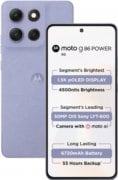- Home
- Mobiles
- Mobiles Reviews
- iPhone 11 Pro Max Review
iPhone 11 Pro Max Review
What's in a name?
iPhone 11 Pro Max price in India starts at an eye-watering Rs. 1,09,900
What is a ‘Pro' device? A joke popular in Apple circles goes that anything that's available in Space Grey and costs a small fortune qualifies. We've seen Apple use the Pro tag in a wide variety of devices, usually with a fair amount of justification.
The Mac Pro and iMac Pro use server-grade chips and ECC RAM (among other components) to differentiate themselves from the Mac Mini and iMac respectively. The MacBook Pro has traditionally used faster chips to offer performance levels that other MacBooks simply cannot achieve. The iPad Pros started off by differentiating themselves with Apple Pencil and Smart Keyboard support, though recent updates to the iPad lineup mean only their use of the Type-C port and fancier display panels make them stand out.
On its website, Apple is calling the new iPhone 11 Pro and iPhone 11 Pro Max the “first iPhone[s] powerful enough to be called Pro”. At first glance that seems like a weird claim to make, since the iPhone 11 (Review) uses the same chip — and benchmarks indicate it has the same amount of RAM — as its more expensive brethren.
Yes, the iPhone 11 and the iPhone 11 Pro duo differ in significant ways — most notably their displays and battery life, apart from the latter packing in an additional telephoto camera on the rear — but are the changes significant enough to justify the ‘Pro' tag? Before we answer that question, we encourage you to read our iPhone 11 review, since it's an essential starting point for many things we will be talking about.
iPhone 11 Pro Max design
Let's address it right at the start: the camera bump on the rear — or the camera island, as we called it in our iPhone 11 review — is not very pleasant to look at. It's roughly — maybe exactly, we didn't have vernier callipers on hand — the same size as the island on the iPhone 11, except it houses three cameras, in addition to the True Tone flash and a microphone.
While it doesn't look as ugly in person as when we saw the first the leaked renders several months ago — or maybe we've just become accustomed to this sight — it's safe to say that this isn't Apple's best design work. We don't have a problem with the presence of the bump but we can't claim to be fans of the lens arrangement that Apple has gone with.
![]() It's safe to say we are not fans of this design
It's safe to say we are not fans of this design
It's quite possible that Apple engineers felt this arrangement was necessary to get the best possible performance out of three cameras — moving any of the lenses by even a millimetre would require adjusting the algorithms that combine data from multiple sensors, something all companies do as part of their development process — but we sure wish a more aesthetically pleasing solution could've been found. We've all complained in the past about Apple picking form over function, so maybe this is just Cupertino's payback for all that criticism.
If you look beyond the camera island, the iPhone 11 Pro Max is a lot like its predecessor, the iPhone XS Max (Review), except that the glass on the back now has a textured matte finish. This gives the phone a different — read nicer, in our books — look and in-hand feel compared to the iPhone 11 and previous-generation iPhone models.
While we weren't impressed with the new Midnight Green finish in the brief time that we spent with an iPhone 11 Pro Max at the hands-on area at the Steve Jobs Theatre following Apple's launch event, it's definitely grown on us in the few days that we've spent with our review unit. It's still hard to differentiate this colour from the Space Grey variant in certain light conditions, but the dark, understated green comes through when light shines off the iPhone's back.
The iPhone 11 Pro and iPhone 11 Pro Max are also available in Silver and Gold, each with a matching polished steel frame, or band as Apple likes to call it. Like the iPhone 11, the ‘iPhone' branding is missing from the back of the phones. The grille at the bottom of the iPhone 11 Pro duo is asymmetrical (just as it was on the iPhone XS and iPhone XS Max), though we are perhaps one of three people in the world who even notice this.
At 158x77.8x8.1mm, the iPhone 11 Pro Max is 0.5 taller, 0.4mm wider, and 0.4mm thicker than the iPhone XS Max, but perhaps more importantly, at 226g, it's a full 18g heavier as well. That's quite something for a company that's traditionally been obsessed with making everything thinner and lighter with successive generations. The fact that the iPhone 11 Pro Max offers much better battery life than the iPhone XS Max — more on that later — is an indication that most of the weight has been put towards accommodating a bigger battery, which is another sign that at least in some cases Apple is no longer afraid to sacrifice design at the altar of functional gains.
![]() The iPhone 11 Pro Max (right) is marginally thicker and heavier than the iPhone XS Max (left)
The iPhone 11 Pro Max (right) is marginally thicker and heavier than the iPhone XS Max (left)
Switching from the iPhone XS Max as our daily driver, we got used to the additional weight pretty quickly, but it's safe to say that this phone might be a step too far for many people. If you feel this way, you would do well to opt for the iPhone 11 Pro, which offers the same package in a smaller body, with only slightly worse (claimed) battery life.
iPhone 11 Pro Max display, performance, and battery life
The iPhone 11 Pro Max packs a 6.5-inch 1242x2688 display, which is the same size and has the same number of pixels as the one on the iPhone XS Max, but there are a few improvements. For starters, the iPhone 11 Pro Max display has an increased peak brightness of 800 nits, compared to 625 nits on its predecessor. In fact, the display is capable of hitting even brighter levels — up to 1200 nits — when viewing HDR10 or Dolby Vision videos, or while looking at HDR photos.
This makes watching HDR content on iPhone 11 Pro Max a visual treat, especially in scenes with really bright areas alongside dark shadows. Throw in Dolby Atmos support on the iPhone 11 trio's built-in speakers and the iPhone 11 Pro Max is a portable entertainment powerhouse. Just like the iPhone 11, the iPhone 11 Pro Max also claims to offer improved Bluetooth audio streaming range thanks to Bluetooth beamforming. You also get Bluetooth 5, Wi-Fi 6, and Gigabit LTE, if your network supports it.
The iPhone 11 Pro and iPhone 11 Pro Max drop 3D Touch, marking the end of Apple's experiment with the technology. The iPhone XR was the first new phone (other than the iPhone SE (Review)) to ship without 3D Touch since the technology made its debut with the iPhone 6s (Review) and iPhone 6s Plus (Review).
Just like the iPhone XR, most of 3D Touch's functionality can still be accessed by long-pressing, or Haptic Touch, as Apple calls it. In that sense, the iPhone XR was an experiment to see if anyone misses 3D Touch, and the answer clearly seems to have been no.
![]() The display on the iPhone 11 Pro Max is great
The display on the iPhone 11 Pro Max is great
The iPhone 11 Pro Max is IP68 rated, but it can now apparently survive at a depth of 4 metres for up to 30 minutes, compared to 2 metres on its predecessor. Do remember that Apple's warranty, like those of most other OEMs, does not cover liquid damage. What's unchanged is the storage options: 64GB (Rs. 1,09,900), 256GB (Rs. 1,23,900), and 512GB (Rs. 1,41,900). Given their relatively high prices, we would've liked at least 128GB of storage with the base variant.
All three new iPhone models are powered by Apple's new A13 Bionic SoC and, as expected, they aced all our tests, ranking comfortably ahead of all other smartphones. In fact, the closest competitors that the iPhone 11 trio have in terms of raw power are last year's iPhone models, which tells you everything you need to know about Apple's lead in the SoC department.
Both in terms of benchmarks and real world performance, the iPhone 11 Pro Max was pretty similar to the iPhone 11, and we encourage our readers to check out our iPhone 11 review for more details. As before, Face ID is available to unlock your phone, and Apple's is possibly the fastest and most reliable face recognition implementation out there.
Apple is promising the “longest battery life in an iPhone” with the iPhone 11 Pro Max, and with good reason. The smartphone lasted two full days of medium to heavy usage, which for us involved a little bit of gaming, shooting some videos and photos, a bit of social media, and checking emails. We got 19 hours and 27 minutes of playback time in our HD video battery loop test, which is exceptionally good.
The iPhone 11 Pro and iPhone 11 Pro Max finally ship with fast chargers in the box. Apple has moved to a Type-C charger, which is good news for those who would like to use the bundled cable with their Type-C-only MacBooks.
The bundled charger can take the iPhone 11 Pro Max from empty to 46 percent in 30 minutes, and to 81 percent in 60 minutes, which isn't as quick as many of today's Android smartphones can manage, but a welcome addition to the iPhone lineup, and more than acceptable overall.
A full charge took nearly two and-a-half hours, and we suspected that's likely down to iOS 13's new ‘Optimised Battery Charging' setting — on by default — which looks to optimise for long-term battery life by slowing down charging once the battery level hits 80 percent. Indeed, when we tried charging the phone with Optimised Battery Charging turned off, we could charge it from empty to 100 percent in 1 hour and 52 minutes.
Wireless charging is supported with speeds similar to previous-generation iPhone models.
iPhone 11 Pro Max software and cameras
The iPhone 11 trio ship with iOS 13 out of the box, which brings a host of new features. First up is a system-wide Dark Mode, which — when on — flips the default view from black text and controls on white backgrounds to white text on black backgrounds. All system apps support Dark Mode, though some aspects take time getting used to.
Traditionally, Safari has used a grey fill in the address bar as well as the menu bar and the toolbar at the bottom to indicate that you are in Private Mode. With Dark Mode in iOS 13, however, only the background of the address bar is changed to black, which isn't as easily discernible as before.
![]() Safari in regular vs private mode in iOS 12 (left) and in dark mode on iOS 13 (right)
Safari in regular vs private mode in iOS 12 (left) and in dark mode on iOS 13 (right)
Dark Mode can quickly be toggled on or off via the Control Centre, and the changes reflect instantly. You can also schedule Dark Mode to kick in automatically during certain hours. Third-party developers can offer alternative colour schemes for their apps when Dark Mode is activated.
The Photos app has been revamped to help those with large libraries find and manage their photos better. The Photos tab within the app is now split into Years, Months, Days, and All Photos, making it easier to quickly jump to the vacation you took in June last year, for example. The app now also includes more powerful photo and video editing controls than before, which is something that pros will appreciate.
Notably, while editing Portrait shots, you can now adjust the position and intensity of your studio lighting, which can be pretty useful if you know what you are doing. A new Portrait Lighting effect called High-Key Light Mono gives your subjects a monochromatic look on a white background.
Reminders is another app that has been completely revamped, offering you more features and more granular controls than before. The app new presents four Smart lists at the top: Today, Scheduled, Flagged, and All. You can add attachments to your reminders, or create new kinds of reminders that pop up when you are messaging a specific person, which can be pretty handy. There's support for subtasks and grouped lists as well.
It's worth pointing out that upon first launching Reminders on any device running iOS 13, you will be prompted to upgrade your reminders and notes stored on iCloud. If you go through with the upgrade, they will become inaccessible on iOS devices running anything older than iOS 13, as well as on Macs running anything except macOS Catalina.
![]() iOS 13 ships with a revamped, more powerful Reminders app
iOS 13 ships with a revamped, more powerful Reminders app
Messages gets a few new features too, the most important being greatly improved search. You can finally see more than one instance of the search term in a conversation, which fixes a major pain point with Messages. The app also lets you control what name and photo people see with outgoing iMessages, and even who gets to see this name and photo.
Then there are a couple of much-needed system-wide improvements. The built-in keyboard finally supports swipe typing, which lets you simply swipe your finger over the keyboard to type words. We are personally not fans on this input method but we know many who swear by it. This also means you don't need to install any third-party apps or toggle keyboards to use this feature. In our limited time testing the method — which Apple is calling QuickPath — the system did a good job of detecting the words that we were intending to type.
iOS 13 also fixes another long-standing annoyance — the volume indicator. That's right, now when you change the volume while watching a video, you will no longer see a huge graphical indicator in the middle of the screen that blocks the very video you are watching. Instead, you will see a much smaller control on the side of the video, which does the job just fine. Third-party apps including YouTube had rolled out their own solutions to work around this problem, but we're glad to have a system-wide fix once and for all.
The good-old system-wide Share Sheet has a brand new look that puts AirDrop and recent Messages/ Mail recipients in a horizontally-scrolling row at the top, followed by the list of third-party apps similar to what we had in iOS 13. Additional actions have been brought out of their own row in iOS 12 and are now present as a vertically scrolling list, grouped by context. Overall, the Share Sheet feels a lot more cluttered but this could potentially aid the discovery of previously buried options, so we have mixed feelings about this change at this stage.
![]() Share Sheet in iOS 12 (left) and iOS 13 (right). Note that the two phones have different sets of apps installed.
Share Sheet in iOS 12 (left) and iOS 13 (right). Note that the two phones have different sets of apps installed.
iOS 13 also brings a host of other features such as the ability to plug in external drives to your iOS devices, big improvements to CarPlay, and a new feature called Sign in With Apple that's designed to let you use third-party apps and services while limiting the amount of information you share with them. Do note that since the iPhone still uses the Lightning connector, you will need the USB adapter to use most external drives.
Apple is also forcing apps to be more transparent about how they use location data and if they use Bluetooth for anything other than streaming audio. This will manifest for users in the form of permission prompts when the app tries to use the feature for the very first time.
You will have the chance to give apps one-time access to your location, which is handy if you need to do this, say, during the signup process but want to protect your location data later. Apps will no longer be able to ask for background access to your location when they first launch. However, if you've already granted an app permission to use your location while it's being used, it can prompt you to take this to the next level by requesting background location access when needed.
![]() iOS 13 brings several privacy-focused features like enhanced controls for sharing location data with apps and granting them access to Bluetooth (right)
iOS 13 brings several privacy-focused features like enhanced controls for sharing location data with apps and granting them access to Bluetooth (right)
We appreciated the extra level of granularity that the location data prompts now offer, though we believe a lot of users may find the Bluetooth-related prompts to be confusing and may end up granting — or denying — apps access without complete information. Though some third-party developers use Bluetooth for tracking, it's also being used by others to enable some convenient features.
There are even a few India-centric features such as keyboards for Assamese, Bodo, Dogri, Kashmiri (Arabic, Devanagari), Konkani (Devanagari), Manipuri (Bangla, Meetei Mayek), Maithili, Nepali, Sanskrit, Santali (Devanagari, Ol Chiki), and Sindhi (Devanagari, Arabic), as well as next-word predictions when typing in Hindi. The new bilingual Hindi (Latin) and English keyboard also supports typing predictions.
Four new system fonts — Gujarati, Gurmukhi, Kannada, and Odia — have been added, and there are 30 new document fonts for Assamese, Bangla, Gujarati, Hindi, Kannada, Malayalam, Marathi, Nepali, Odia, Punjabi, Sanskrit, Tamil, Telugu, and Urdu.
Siri can now speak English in an Indian accent, though it isn't ready to start conversing in any Indian languages just yet. Apart from an accent that will sound more familiar to India ears, this means that Siri will use ‘lakhs' instead of ‘hundred thousands' when referring to large number. Not all kinks seem ironed out yet though as we noticed Siri sometimes said the word “period” instead of actually pausing in between sentences (see screenshot below). At least Apple Maps now supports turn-by-turn navigation in India, so there's one less thing for us to complain about.
![]() Give Siri an Indian accent and it says "lakhs" instead of "hundred thousands" (left), though it struggled with the bit on the right for some reason
Give Siri an Indian accent and it says "lakhs" instead of "hundred thousands" (left), though it struggled with the bit on the right for some reason
If you are actively using two numbers on your iPhone, you'll be pleased to note that iOS 13 now lets you link both the numbers to your iMessage and FaceTime accounts, removing a limitation that we noted in your iPhone XR review where we dove in-depth into the software experience of using a dual-SIM iPhone.
We did run into some bugs though. After taking a screenshot on the iPhone 11 Pro Max, we couldn't immediately save it to Files or share it using the Share Sheet. Instead, we had to go back to the home screen, go back into Photos, and then invoke the Share Sheet. Interestingly, we didn't face the same problem on the iPhone 11.
The camera setup on the iPhone 11 Pro and iPhone 11 Pro Max is identical to that of the iPhone 11, except they feature an additional f/2.0 12-megapixel sensor paired with telephoto lens. This allows the iPhone 11 Pro duo to offer 2x optical zoom, while also utilising the telephoto lens for Portrait Mode. That's right, with the iPhone 11 Pro duo, Portrait Mode is available on both Telephoto and Wide cameras — you can switch between the two with an easy-to-miss on-screen button that shows up at the bottom-left.
![]()
![]()
![]() iPhone 11 Pro's Wide (top), Ultra Wide (middle), and Telephoto (2x zoom, bottom) cameras in action - tap to see full-sized images and check out our iPhone 11 review for more camera samples
iPhone 11 Pro's Wide (top), Ultra Wide (middle), and Telephoto (2x zoom, bottom) cameras in action - tap to see full-sized images and check out our iPhone 11 review for more camera samples
In low-light conditions, the performance of the Telephoto camera is slightly worse than that of the Wide camera, but it's appreciably better than that of the Ultra Wide. In all other aspects, the performance of the iPhone 11 Pro Max's cameras is identical to that of the iPhone 11 and we encourage you to read our iPhone 11 review for a more in-depth look at how well they work.
![]()
![]() Portrait mode (left/ top) and iOS 13's new Portrait Lighting effect High-Key Light Mono (right/ bottom) — tap to see full-sized images
Portrait mode (left/ top) and iOS 13's new Portrait Lighting effect High-Key Light Mono (right/ bottom) — tap to see full-sized images
![]() Tap to see full-sized iPhone 11 Pro Max camera sample
Tap to see full-sized iPhone 11 Pro Max camera sample
![]()
![]() iPhone XS Max (top) vs iPhone 11 Pro Max (bottom) — tap to see full-sized images
iPhone XS Max (top) vs iPhone 11 Pro Max (bottom) — tap to see full-sized images
![]()
![]() iPhone XS Max (top) vs iPhone 11 Pro Max with Night Mode (bottom) — tap to see full-sized images
iPhone XS Max (top) vs iPhone 11 Pro Max with Night Mode (bottom) — tap to see full-sized images
To summarise, Night Mode is potentially the biggest new addition to the new iPhone models, and it greatly enhances the new iPhones' low-light photography credentials, making them contenders for being the best smartphone cameras in all conditions. The Ultra Wide camera gives you a new perspective, and the telephoto lens on the iPhone 11 Pro duo with its 2x optical zoom is a handy tool to have when you want to get closer to the action.
The qualities of selfies is improved as well thanks to a brand new front-facing camera and video recording is improved with improved stabilisation and support for extended dynamic range for 4K videos up to 60 fps.
Verdict
A much better writer than this one once asked, “What's in a name? That which we call a Pro by any other name would work as sweet.” With due apologies to The Bard, you hopefully get the point. Whether the iPhone 11 Pro Max is worthy of the ‘Pro' moniker or not is a debate that can continue, but there's no doubting its credentials as a top-notch, excuse the pun, phone.
The somewhat conservative design aside, we struggled to find any real shortcomings with the iPhone 11 Pro Max — the display is excellent; the performance and battery life are as good as you can get; and the cameras, now with Night Mode, can give any other smartphone a run for its money. Heck, Apple has even included a fast charger with this one, so all is good with life, right? Well, almost.
As we mentioned, we would've liked to see more storage on the base variant — this is a ‘Pro' device after all — and Android phones out there offer faster wireless charging and bundled chargers that are much faster than Apple's. The iPhone 11 Pro Max could also be too much of a handful for many people thanks to its size and weight, which would make the iPhone 11 Pro a better bet for many looking for the best the Apple world has to offer. Then there's the small matter of the price.
The iPhone 11 Pro Max starts at an eye-watering Rs. 1,09,900, which is a lot of money to spend on a phone. For most people, it would be hard to justify spending the premium over the iPhone 11 — or even leading Android smartphones such as the Galaxy S10 trio or the Galaxy Note 10 duo — but if you want the iPhone that offers the absolute best of everything, the iPhone 11 Pro Max is the one to get. Though we haven't tested it, the iPhone 11 Pro should offer almost exactly the same experience as the Pro Max in all departments other than battery life, and it's available starting at a slightly lower price.
iPhone 11 or iPhone XR: Which is the best iPhone for India? We discussed this on Orbital, our weekly technology podcast, which you can subscribe to via Apple Podcasts or RSS, download the episode, or just hit the play button below.
For the latest tech news and reviews, follow Gadgets 360 on X, Facebook, WhatsApp, Threads and Google News. For the latest videos on gadgets and tech, subscribe to our YouTube channel. If you want to know everything about top influencers, follow our in-house Who'sThat360 on Instagram and YouTube.
Related Stories
- Samsung Galaxy Unpacked 2025
- ChatGPT
- Redmi Note 14 Pro+
- iPhone 16
- Apple Vision Pro
- Oneplus 12
- OnePlus Nord CE 3 Lite 5G
- iPhone 13
- Xiaomi 14 Pro
- Oppo Find N3
- Tecno Spark Go (2023)
- Realme V30
- Best Phones Under 25000
- Samsung Galaxy S24 Series
- Cryptocurrency
- iQoo 12
- Samsung Galaxy S24 Ultra
- Giottus
- Samsung Galaxy Z Flip 5
- Apple 'Scary Fast'
- Housefull 5
- GoPro Hero 12 Black Review
- Invincible Season 2
- JioGlass
- HD Ready TV
- Laptop Under 50000
- Smartwatch Under 10000
- Latest Mobile Phones
- Compare Phones
- iQOO Z10 Turbo+
- Vivo T4R 5G
- Ulefone Armor 33 Pro
- Ulefone Armor 33
- Redmi Note 14 SE 5G
- Lava Blaze Dragon 5G
- Infinix Smart 10
- Realme 15 Pro 5G
- Samsung Galaxy Book 4 Edge
- Acer Nitro Lite 16
- Honor Pad X7
- Honor Pad GT 2 Pro
- CMF Watch 3 Pro
- boAt Valour Watch 1 GPS
- TCL C72K QD Mini‑LED TV
- Haier 43 Inch QLED Ultra HD (4K) Smart TV (43H6E)
- Asus ROG Ally
- Nintendo Switch Lite
- Haier 1.6 Ton 5 Star Inverter Split AC (HSU19G-MZAID5BN-INV)
- Haier 1.6 Ton 5 Star Inverter Split AC (HSU19G-MZAIM5BN-INV)


















